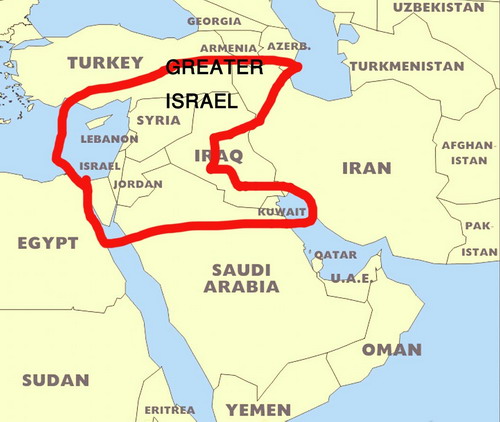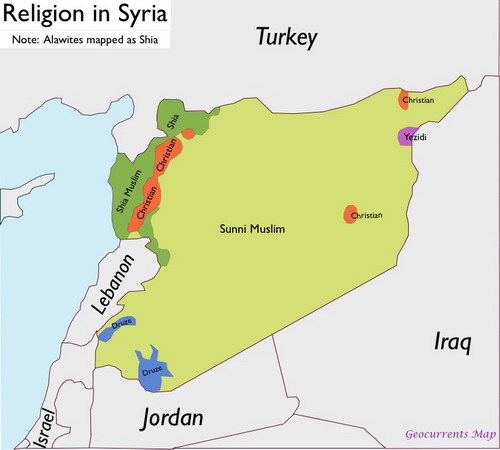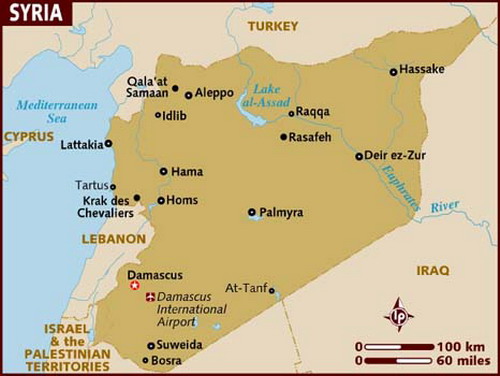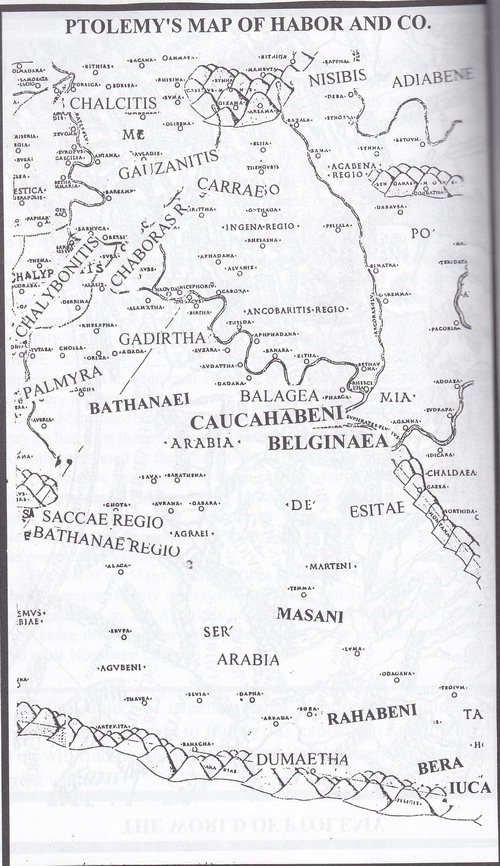Syria and its Neighbors no.2  |
|
This Site |
Site Map Contents in Alphabetical Order |
|
Brit-Am Discussion Group |
Research Recognition Reconciliation | Contents by Subject |
 Syria and its Neighbors no.2 Contents: 11. Independent Syria: The Early years 12. Israelite Tribes and their Claim to Syria: Reuben 13. The Land of Eastern Israel and Syria before the Exile according to the Geography of Ptolemy 14. Two Places in the Bible known as Damascus? 15. The Jews of Syria (a) Overall Picture. Wikipedia Extracts (b) Aleppo Codex (c) Attitudes to conversion (d) Descendants of David amongst Syrian Jews, the Dayan Family 
11. Independent Syria: The Early years Syria became independent on April 17, 1946. Syrian forces joined the Arab coalition against the Jews in Palestine in 1948 and were defeated. In 1949 Syria endured a succession of military coups and the rise of the Ba'ath Party. # In 1958, Syria and Egypt were united through a political agreement into the United Arab Republic. The UAR lasted for three years. In 1961, it broke apart when a group of army officers seized power and declared Syria independent. # The early Baath party had been dominated by Syrian Christians and secular Sunni Muslims. Alawites were prominent in the armed forces. In 1966 a group of mainly Alawite military officers took control of the government In 1970, then Air Force General, Hafez al-Assad, an Alawite, came to power.  Wikipedia comments: # Robert D. Kaplan has compared Hafez al-Assad's coming to power to "an untouchable becoming maharajah in India or a Jew becoming tsar in Russia ?an unprecedented development shocking to the Sunni majority population which had monopolized power for so many centuries." In 1971, al-Assad declared himself president of Syria, a position the constitution at the time allowed only for Sunni Muslims to hold. ... In 1974... Musa Sadr [a Shiite religious authority], issued a fatwa [religious legal ruling] stating that Alawites were a community of Twelver [mainstream] Shi'ite Muslims. Under the authoritarian but secular Assad government, religious minorities were tolerated more than before, but political dissidents were not. In 19811 when the Muslim Brotherhood mounted an anti-government Islamist insurgency, Hafez Assad staged a military offensive against them which has since been referred to as the Hama massacre. # Note that until 1974 the Alawites had not been considered Muslims. Even today most Muslims do not recognize the Alawites as co-religionists. Hama is in northern Syria on the Orontes River. In 1981, the people of Hama rebelled against the rule of Assad for religious reasons and resentment of Alawite domination. There followed the Hama massacre of 1982, in which "at least 10,000 Syrian citizens were killed, while others put the number at 20,000 (Robert Fisk), or 40,000 (Syrian Human Rights Committee)." Army casaulties were about 1000. 12. Israelite Tribes and their Claim to Syria: Reuben Reuben in the Middle East before the Exile (adapted from "The Tribes").  Before the exile, the Tribes of Reuben, Gad, and half-Manasseh had together been settled in GILEAD and Bashan on the eastern banks of the Jordan in the Land of Israel. Later part of the Tribe of Simeon also settled there (1-Chronicles 4:42) alongside offshoots from other Israelite Tribes. "GILEAD" was a name given to a good portion of the Land of Israel east of Jordan including that in which the Tribe of Reuben dwelt. Gilead was also the name of a son of Machir son of Manasseh. The Galaadi or Galatians in Celtic France (Gaul) received their name either from the Israelite region of Gilead or from the Israelite clan of Gilead son of Manasseh who dwelt in part of Gilead. This is worth emphasizing since it can cause confusion: "Gilead" was an important clan in the Tribe of Manasseh east of the Jordan but the name "Gilead" could also be applied to the whole Israelite area east of the Jordan in which settled Reuben, Gad, and the half-tribe of Manasseh. The clan of Gilead comprised most of the Manasseh group that had been east of the Jordan in the Land of Israel and had neighbored Reuben who in turn had adjoined Simeon in the south. The eastern section of the Land of Ancient ISRAEL on Ptolemy's map is referred to as "Arabia". The Tribe of REUBEN, called "Rahabbanai", is listed in eastern Syria and west of the Euphrates . In very Ancient Times (long before the Northern Israelites were exiled) the Mari correspondence of Northern Syria on the Euphrates mentions the Rabeans (of Reuben) alongside a group from Benjamin (Banu/Maru Yaminas) and Gad (Beni Samal and Zapunni both from Tsefion of Gad). Manasseh was also recalled from this region and was referred to as "Manas" and as "Mentiu". A Ruling Clan of Davidiim who were probably descendants of David was mentioned. Reuben in the Land of Israel east of the Jordan adjoined half-Manasseh of Joseph and Gad. 13. The Land of Eastern Israel and Syria before the Exile according to the Geography of Ptolemy HABOR AND THE REST The Map showing the location of Habor also depicts a large section of the Middle East. It shows areas settled by Israelite Tribes long before the Exile as well as regions in which Israelites were re-settled by the Assyrians after the Exile. According to the Bible (1-Chronicles chapter 6) the Tribes of Gad and Reuben fought against Arabian tribes and settled in their lands "until the time of exile" (1-Chronicles 6:22). The former presence of Israelite Tribes in northern Arabia and Syria prior to the exile is recalled in some of the place-names mentioned by Ptolemy in the Land termed "ARABIA" on his Map. As well as the Tribes of Gad and Reuben the area east of the Jordan River was also settled by the half-tribe of Manasseh along with a portion from Simeon and contingents from Judah, Benjamin, and other Tribes. The clan of Yacin (Icen) from Simeon is recalled in IUCA in the south-east near the Persian Gulf. This area includes the oil-rich fields of present-day Kuwait and the Iraqi oil fields and it is interesting to note that the region once belonged to Israel. The clan of Yacin later in Scythia became known as the Sacae-Eucae and Eucatae and in northern Europe as the Saxon-Euci and in Celtic Britain as the ICENI neighbors to the SIMENI. Boudicca, the Celtic Queen in Ancient Britain who led a revolt against Roman Tyranny belonged to the Iceni tribe. West of Iuca on the Map is Bera. Beria is a clan name amongst the Tribes of Benjamin, Ephraim, and Asher. Another acceptable way of pronouncing the Hebrew spelling of "Beria" gives "Beria-g-h" or "Ver-iag" which national name re-appeared amongst Scandinavian and Khazar groups. The name RAHABENI ON PTOLEMY'S MAP IS A FORM FOR REUBEN and was to be repeated in Serica (east of Scythia) as the RHABBANAEI WHO GAVE RISE TO THE RIBUARI FRANKS IN EUROPE. The name MASANI on Ptolemy's Map derives from Manasseh. The inversion of syllables ("Mas-ani" for "Men-eseh") is a common phenomenon. The Masani were later recalled in northern Holland and from there they crossed over to England. Furthur north, the BALAGAEA and BELGINAEA co-relate to the name BELAH (pronouncable as "Bela-g-h") which was a clan name from the Tribe of Bejamin and was to re-appear in the BELGAE who gave their name to BELGIUM. CAUCHABENI means "Sons (Beni) of Chaggi" or Haggi (Num.26) whose name in Hebrew began with the letter HETH, which is transliterable either as "h" or as "ch". Haggi (Chaggi) was one of the Clans of Gad which in Scythia became known as the Cachage Scythae and as the Huga. Later in West Europe they were recorded as the Cauki (Chauci) or Hugo Franks. GADIRTHA recalls the place name Gadir. This place-name occurs several times within the Land of Israel and may also be associated with GAD. Gadira was also the name of an important port in southern Spain linked with the Phoenicians, Tarshish, and the Celts of early Ireland and Britain. Much of the region east of the Jordan settled by the Tribes of Reuben, Gad, and half Manasseh in the Bible (Deuteronomy ch.4) is termed BASHAN. In Aramaic Bashan was written as BATHAN and on the Map is recalled in the BATHANAEI and BATHANAE REGIO (i.e. Kingdom of Bashan) adjacent to SACCAE REGIO. The Mesopotamian Sumerians called the Bashan, "BASIL". Later the Royal Scythians were named Scythae Basilae and these gave their name to SCANDINAVIA which was originally called "SCATANAVIA" or Land of the Scyths. Scandinavia according to the Roman Geographer, Pliny, was also known as "BASILIA". The Kingdom of the SACCAE (Saccae Regio) besides Bathanaea has a clear Scythian connection since "SACCAE" was the contemporary Middle Eastern term for Scyth and the name is believed to be a derivative of "Isaac". The appellation "Saxe" or "Saxon" is a further development of the same name. The Map shows GAUZANITIS and the CHABORIS RIVER and CHALYBONITIS. In this area the presence of Israelite exiles from Samaria has been testified to by the finds of inscriptions. Gauzanitis has been equated with the River Gozan in the verse concerning the Assyrian deportation: 'THE KING OF ASSYRIA took Samaria and carried Israel away into Assyria, and placed them in Halah, and in Habor, the River Gozan, and in the cities of the Medes" (2-Kings 17: 6). The Talmud seems to identify the River of Gozan with the Ouzan ['Ouzan' is pronounced locally as "GOUZAN"] River further to the northeast, called the "Cyrus" by Ptolemy. The region of "HABOR" (pronounceable as "Chabor"), to which Israelites were also taken, probably encompassed the CHABORAS River area as well as Nisibis and the adjoining expanse of Adiabene according to the Talmud (Kiddushin 72, Adiabene = Hadayb). The CHALYBONITIS was named after the Chalybes who were descendants of the CHELUBAI (1-Chronicles 2:19) from Hetzron of Judah. They were descended from the sons of Chaleb ben Jefunai and associated with the Keni and Kenizai who were metal workers. After their exile the Chalybes were associated in Greek records with the Cimmerians. The Greeks ascribed to them the invention of iron processing. They were later located in the Caucasian area of Iberia (Georgia) where the Cimmerians were also once centered. Justin reported a group of Chalybes in the area of Galatia in northwest Spain where too they were noted as metallurgical experts. From Spain they apparently passed over into Ireland and Celtic Britain. Zechariah 10:10 and Micah 7:14 speak of the return of Ephraim and the Tribes to Lebanon, Gilead, and Bashan. 14. Two Places in the Bible known as Damascus? Ezekiel (47:17) placed Damascus on the northern or north east boundary of Israel. This border however, we know from other sources, reached at least up to the Euphrates River (Genesis 15:18). Different commentaries have shown how the Damascus mentioned by Ezekiel and elsewhere in the Bible was in a different region from the city we call Damascus today. Scripture may in effect under the name Damascus refer to one of two different places, depending on the context. The city and region we call Damascus today in Ancient Times was known as the Land of Apum (or Abum) and translated as Land of the Donkey. There was another place with the same name in the Habor region east of the Euphrates. The two areas may have been ethnically connected. Indications are that the Land of Apum east of the Euphrates was also known as Damascus just as the more southern present-day Damascus was also identified with the Land of Apum. See: "Brit-Am Now"- 402 #3. The NORTHERN BORDERS of Biblical Israel http://britam.org/now/now402.html SCROLL DOWN!! to DAMASCUS, Near Eastern Archaeology in the Twentieth Century, edited by James A. Sanders, 1970, p. 173, note 2. Damascus was also known as Apum. article, "NORTHERN CANAAN AND THE MARI TEXTS" by Abraham Malamat # the land of Apum mentioned here must be differentiated from another country of the same name occurring ion the Mari and Cappadocian texts, located in the Habor region". Quotes from M. Faulkner, AfO, 18, 1957, p.2 W. F. Albright, YGC (1968), p.58 n.30 W. F. Albright, "The land of Damascus between 1850 and 1750 B.C.," BASOR, no. 83 (1941), p.30 ff. This is confirmed by: "Is the Area of Apum-Damascus Mentioned in the Mari Archives?" by Wayne T. Pitard, BASOR, no.264, November 1986 www.jstor.org/stable/1357021 Amos prophesied that the northern Ten Tribes of Israel would be exiled "beyond Damascus". The intention apparently was to the northern area known as Damascus and not that of today. Amos 14: 25 Did you bring to me sacrifices and offerings the forty years in the wilderness, O house of Israel? 26 You shall take up Sakkuth your king, and Kaiwan your star-god, your images that you made for yourselves; 27therefore I will take you into exile beyond Damascus, says the Lord, whose name is the God of hosts. 15. The Jews of Syria (a) Overall Picture. Wikipedia Extracts From Wikipedia, the free encyclopedia http://en.wikipedia.org/wiki/Syrian_Jews Extracts: Total population 175,000 to 200,000(est.) Regions with significant populations Languages Hebrew, Arabic, French, English Religion Orthodox Judaism Related ethnic groups Mizrahi Jews, Sephardi Jews, other Jewish groups, other Syrians, other Levantines Syrian Jews.. are Jews who lived in the region of the modern state of Syria, and their descendants born outside Syria. Syrian Jews derive their origin from two groups: from the Jews who inhabited the region of today's Syria from ancient times (known as Musta'arabi Jews, and sometimes classified as Mizrahi Jews, a generic term for the Jews with an extended history in the Middle East or North Africa); and from the Sephardi Jews (referring to Jews with an extended history in the Iberian Peninsula, i.e. Spain and Portugal) who fled to Syria after the expulsion of the Jews from Spain (1492 CE). There were large communities in Aleppo (the Halabi Jews) and Damascus (the Shami Jews) for centuries, and a smaller community in Qamishli on the Turkish border near Nusaybin. In the first half of the 20th century a large percentage of Syrian Jews emigrated to the U.S., Latin America and Israel. Most of the remaining Jews left in the 28 years following 1973, due in part to the efforts of Judith Feld Carr [a Jewess from Canada], who claims to have helped some 3,228 Jews emigrate; emigration was officially allowed in 1992. The largest Syrian Jewish community is located in Brooklyn, New York and is estimated at 75,000 strong. There are smaller communities elsewhere in the United States and in Latin America. There have been Jews in Syria since ancient times: according to the community's tradition, since the time of King David, and certainly since early Roman times. In 70 BC there were about 10,000 Jews in Damascus.... Many Sephardim arrived following the expulsion from Spain in 1492, and quickly took a leading position in the community. In the eighteenth and nineteenth centuries, some Jews from Italy and elsewhere, known as Senores Francos, settled in Syria for trading reasons, while retaining their European nationalities. Jews who are members of the Kurdish community (hailing from the region of Kurdistan) represent another portion of Syrian Jewry whose presence in Syria predates the arrival of Sephardic Jews [from Spain] .. There has been a Syrian presence in Jerusalem since before 1850... A further group immigrated to Palestine around 1900, and formed the Ades Synagogue in Nachlaot [Jerusalem]. This still exists, and is the main Aleppo rite synagogue in Israel, though its membership now includes Asiatic Jews of all groups, especially Kurdish. There is also a large Syrian community in Holon and Bat Yam. Many Jews fled from Syria to Palestine during the anti-Jewish riots of 1947. After that, the Syrian government clamped down and allowed no emigration, though some Jews left illicitly. In the last two decades, some emigration has been allowed, mostly to America... Norval Marley the father of Bob Marley was British and of Syrian Jewish ancestry. (b) Aleppo Codex The Aleppo Codex, now known in Hebrew as Keter Aram Tsoba, is the oldest and most famous manuscript of the Bible. Written in Tiberias in the year 920, and annotated by Aaron ben Asher, it has become the most authoritative Biblical text in Jewish culture. The most famous halachic authority to rely on it was Maimonides, in his exposition of the laws governing the writing of Torah scrolls in his codification of Jewish law (Mishneh Torah)... At the end of the 14th century the Codex was taken to Aleppo, Syria (called by the Jews Aram Zobah, the biblical name of part of Syria) -this is the origin of the manuscript's modern name. ...In 1958, the Keter [i.e. the Codex] was smuggled into Israel ... Modern editions of the Bible, such as the Hebrew University's "Jerusalem Crown" and Bar-Ilan University's "Mikraot Gedolot ha-Keter", have been based on the Codex. The missing sections have been reconstructed on the basis of cross-references in the Masoretic Text of surviving sections, of the notes of scholars who have consulted the Codex and of other manuscripts. The codex is now kept in the Israel Museum, in the building known as "The Shrine of The Book." It lies there along with the Dead Sea Scrolls and many other ancient Jewish relics. (c) Attitudes to conversion At the time of the Mahzor Aram Soba of 1527 and 1560, conversions were clearly accepted, as there are blessings in the Mahzor on the rituals of conversions. However, in the early twentieth century the Syrian Jewish communities of New York and Buenos Aires adopted rulings designed to discourage intermarriage. The communities would not normally carry out conversions to Judaism, particularly where the conversion is suspected of being for the sake of marriage, or accept such converts from other communities, or the children of mixed marriages or marriages involving such converts. However, there are exceptions to the rule, such as conversions for the sake of adoptions always being permitted. Additionally, communal rabbis (such as the late Chief Rabbi Jacob S. Kassin) have occasionally recognized conversions carried out by certain rabbis, such as members of the Israeli Chief Rabbinate. Nonetheless, these rulings strongly discourage people from converting into the Syrian Jewish community as they require them to show commitment to Judaism above and beyond what is required by the normative rabbinical laws of conversion. Hacham Uzziel, then Sephardi Chief Rabbi of Israel, was asked to rule on the validity of this ban. He acknowledged the right of the community to refuse to carry out conversions and to regard as invalid conversions carried out by other communities in which marriage is a factor. At the same time, he cautioned that persons converted out of genuine conviction and recognized by established rabbinic authorities should not be regarded as non-Jewish, even if they were not allowed to join the Syrian community. ... Supporters of the edict argue that it has been demographically successful, in that the rate of intermarriage with non-Jews in the Syrian community is believed to be less than 3%, as opposed to anything up to 50% in the general American Jewish population. Opponents argue that this fact is not a result of the edict, but of widespread attendance at Orthodox day schools, and that a similarly low rate of intermarriage is found among other Orthodox day-schooled Jews despite the absence of any equivalent of the edict. As Syrian Jews migrated to the New World and established themselves, a divide frequently persisted between those with roots in Aleppo (the Halabi Jews, alternately spelled Halebi or Chalabi) and Damascus (the Shami Jews), which had been the two main centers of Jewish life in Syria. This split persists to present-day, with each community maintaining some separate cultural institutions and organizations, and to a lesser-extent, a preference for in-group marriage. (d) Descendants of David amongst Syrian Jews, the Dayan Family http://davidicdynasty.net/mitchell-dayan.html #...'The Book', 'Yashir Moshe'. This book, written in 1864 by Rabbi Moshe Dayan, was a commentary on King Solomon's Shir Hashirim ( Song of Songs). The hidden gem in this book is the genealogy found between the introduction and the commentary. Here, Rabbi Dayan traces the Dayan family lineage straight back to King David. # |
Pleased with what you read?
Through helping us, God willing, you will bring a blessing on yourselves and on others.
Click Here to make an offering. |
 |
